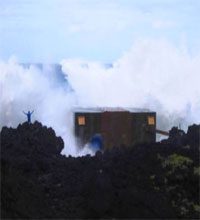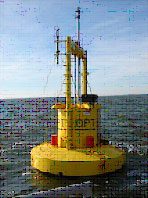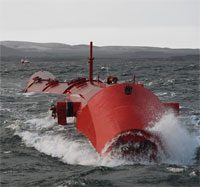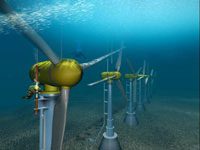Feature: Marine Renewable Energy
Marine renewable energy plays a fundamental role in reducing anthropogenic CO2 emissions. In order to mitigate the effects of the climate change, it is essential to promote and develop this energy. Currently, only offshore wind energy has reached an acceptable level of development to be considered competitive. However, there are other less developed technologies that obtain energy from the seas and oceans, including wave and tidal energy, energy from currents, ocean thermal energy and salinity gradient energy.
Offshore wind energy, with 2,063 installed MW at the end of 2009, is the most developed of the renewable marine energies. Northern European countries currently lead this sector, with the UK and Denmark at the forefront. The main advantage of offshore wind farms compared to those on land is that there are no obstacles to reduce wind speed, so more of the resource can be harnessed.
 Wave energy is produced by the movement of waves. Because wave energy is irregular, a variety of prototypes have been developed to harness it. These include the so-called first generation prototypes that are fixed to structures on the coast (breakers and cliffs) or fixed directly to the seabed. Second generation prototypes include those located off the coast in shallow waters and may include floating structures or structures fixed to the seabed. Finally, third generation prototypes may be floating or submerged structures and are located in deeper waters (up to 100 meters).
Wave energy is produced by the movement of waves. Because wave energy is irregular, a variety of prototypes have been developed to harness it. These include the so-called first generation prototypes that are fixed to structures on the coast (breakers and cliffs) or fixed directly to the seabed. Second generation prototypes include those located off the coast in shallow waters and may include floating structures or structures fixed to the seabed. Finally, third generation prototypes may be floating or submerged structures and are located in deeper waters (up to 100 meters).
Different technologies are being used to harness wave energy. In an Oscillating Water Column (OWC), the movement of the waves makes the water level rise and fall within a semi-submerged chamber that is open on the bottom. This oscillating movement displaces air volume over the water, generating air flow that is capable of powering a turbine.
These installations are usually located close to the coast or on breakers, as is the case of the Mutriku project (Basque Country).
 Other devices used to harness wave energy are called Absorbers or Attenuators. The first is a floating structure capable of absorbing wave energy from any direction. The device moves up and down with the movement of the waves, and this movement is then converted into electric energy.
Other devices used to harness wave energy are called Absorbers or Attenuators. The first is a floating structure capable of absorbing wave energy from any direction. The device moves up and down with the movement of the waves, and this movement is then converted into electric energy.
Attenuators are large, articulated cylinders that are partially submerged and joined by hinges. The wave motion creates movement between these sections, activating a hydraulic system connected to an electric generator.
There are, however, many other devices capable of harnessing wave energy such as overflow systems, the Archimedes Wave Swing-AWS, impact systems or terminators.
Tidal energy obtains energy from the rise and fall of the sea caused by the ebb and flow of the tides. A water storage basin, like a dam, fills with water at high tide and empties at low tide, until it reaches a level that is equal to the water level in the ocean. Water is then passed through a turbine that generates energy.
 There are, however, many other devices capable of harnessing wave energy such as overflow systems, the Archimedes Wave Swing-AWS, impact systems or terminators.
There are, however, many other devices capable of harnessing wave energy such as overflow systems, the Archimedes Wave Swing-AWS, impact systems or terminators.
Tidal energy obtains energy from the rise and fall of the sea caused by the ebb and flow of the tides. A water storage basin, like a dam, fills with water at high tide and empties at low tide, until it reaches a level that is equal to the water level in the ocean. Water is then passed through a turbine that generates energy.
Ocean Thermal Energy Conversion (OTEC) technologies are capable of harnessing the difference in temperature that exists between the ocean surface waters and deeper waters, in other words, what is known as the ocean thermal gradient. A difference of temperature over 20ºC is necessary, so the regions close to the equator and the subtropics are the most adequate for this type of energy.
Despite its potential, research and projects are currently only in a preliminary phase. Experimental facilities have been installed in Hawaii, India and Japan. Among these, the floating platform installed in India in 2001 generates 1MW of power. The platform, called Sagar Shakti (“the power of the ocean” in Sanskrit) was developed by the National Institute of Ocean Technology of India and the University of Saga in Japan. The plant is located 40 kilometers from the coast of Tamilnadu and consists of a floating platform that uses water collected at 1,000 meters depth.
Lastly, other technologies include Osmotic Pressure Energy (also known as Blue Energy) and Saline Gradient Energy.
 The first is based on osmosis, harnessing the difference in pressure between fresh and salt water to produce energy.
The first is based on osmosis, harnessing the difference in pressure between fresh and salt water to produce energy.
The Norwegian State Energy group Statkraft inaugurated the world’s first prototype in the Oslo fjord.
Salinity gradient technology obtains energy from the difference between salt concentration in ocean water and river water. When fresh water is mixed with salt water, the energy that is released can, in theory, be harnessed.
It is important to acknowledge this technology’s potential although it still in the developmental phase and costs are still excessively high.

